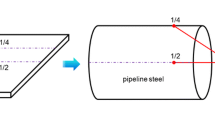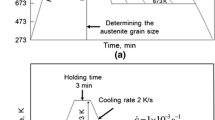Abstract
FH40 ship-building steels with Ce, Zr, Ce–Zr compound treatment were melted in medium frequency vacuum induction furnace. The characteristics such as particle size distribution, average particle size, total amount, and chemical composition of FH40 ship-building steels were investigated by OM and SEM-EDS methods. The results showed after Ce, Zr, Ce–Zr compound treatment, the average particle size decreased from 2.752 to 2.567 μm, the microstructures of experimental steels were refined remarkably, and inclusions distributed more uniformly, while the total amount of inclusions increased from 213.5/mm2 to 672.8/mm2. A1–O in the experimental steel containing 0.0053%Ce and 0.0055%Zr could be transformed into Ce–Zr–O being 33.6%. The inclusions except Al–O can induce the growth of IAF nucleation. Further analysis showed that the morphology of inclusions was affected by the amount of alloying agent addition, the misfit, and particle interfacial energy.
Access this chapter
Tax calculation will be finalised at checkout
Purchases are for personal use only
Similar content being viewed by others
References
Cheng Y, Qi D, Wu M (2011) R&D present status and progress of high strength ship plate steel at home and abroad. Special Steel 32(5):26–30
Yan C, Zhen L (2007) Brief introduction of ship plate production of Japanese iron and steel enterprises. Wide Heavy Plate 13(4):44–48
Li X, Liu C, Jiang M (2015) Effect of M(M = Mg, Zr, Mg–Zr) addition on microstructure and mechanical properties in FH40 ship plates steel. J Central South University (Sci Technol) 46(10):3586–3593
Li C, Lin X (2011) Development of new manufacturing technology of ship building steel and the progress in baosteel. Shanghai Metals 33(4):57–62
Xi T, Xi X, Yuan Z (2003) Progress in research on structure and properties of heat affected zone of steel for high heat input welding. Special Metals 24(5):1–5
Yang Q, Wu H, Ren X, Guo X (1994) Study on the effect of rare earth oxides on weld inclusion and microstructure. Chinese Rare Earths 10(2):151–154
Mizoguchi S, Takamura J (1990) Process sixth international iron and steel congress. In: Control of oxides as inoculants metallurgy of oxides in Steel.ISIJ International, Nagoya, Japan, pp 2331–2342
Takamura J, Mizoguchi S (1990) Proceedings of the 6th international iron and steel congress role of oxides in steels performance, metallurgy of oxides in steels. ISIJ International, Nagoya, Japan, pp 591–597
Karasev AV, Suito H (2008) Characteristics of fine oxides particles produced by Ti /M(M = Mg and Zr) complex deoxidation in Fe-10% Ni alloy. ISIJ Int 48(11):1507–1516
Mizoguchi S, Takamura J (1990) Control of oxides as inoculants metallurgy of oxides in steel. In: Proceedings of sixth international iron and steel congress. ISIJ, Nagoya, pp 2331–2342
Ohmori Y (1971) The isothermal transformation of plain carbon austenite. Trans ISIJ 11:1161–1164
Lee TK, Kim HJ, Kang BY (1971) Effect of inclusion size on nucleation of acicular ferrite in welds. ISIJ Int 40(12):1260–1268
Shim J-H, Oh YJ, Suh JY, Cho YW, Shim J-D, Byun J-S, Lee DN (2001) Ferrite nucleation potency of non-metallic inclusions in medium carbon steels. Acta Mater 49(12):2115–2122
Wu K, Li Z (2007) Intragranular ferrite and microstructure control in low carbon microalloyed steels. J Iron Steel Res 19(10):1–5
Wu K (2006) Three-dimensional analysis of acicular ferrite in aloes-carbon steel containing titanium. Scripta Mater 54(4):569–574
Cheng L, Wu KM (2009) New insights into intergranular ferrite in a low-carbon low-alloy steel. Acta Mater 57(13):3754–3762
Cheng L, Wu K, Wan X (2014) Growth behavior of intragranular ferrite idiomorphs in an Fe–0.09% C–1.48% Mn–0.2 Si steels. Steel Res Int 85(5):836–843
Shim J-H, Byun J-S, Cho YW (2001) Effects of Si and Al on acicular ferrite formation in C–Mn steel. Metall Mater Trans A 32(1):75–83
Yang Z, Wang F, Wang S (2008) Intragranular ferrite formation mechanism and mechanical properties of non-quenched-and-tempered medium carbon steels. Steel Res Int 79(5):390–395
Madariaga I, Gutierrez I, Anders CG (1999) A circular ferrite formation in a medium carbon steel with a two stage continuous cooling. Scripta Mater 41(3):229–235
Zhou Y, Jia T, Zhang X, Liu Z, Misra RDK (2015) Investigation on tempering of granular bainite in an offshore platform steel. Mater Sci Eng A 626:352–361
Thewlis G (2006) Effect of cerium sulphide particle dispersions on acicular ferrite microstructure development in steels. Mater Sci Technol 22(2):153–166
Guo AM, Li SR, Guo J (2008) Effect of zirconium addition on the impact toughness of the heat affected zone in a high strength low alloy pipeline steel. Mater Characterization 59: 134–139
Acknowledgements
Foundation item: Project supported by the National Natural Science Foundation of China (51474088); Project supported by Tangshan outstanding young and middle-aged experts going abroad training
Author information
Authors and Affiliations
Corresponding author
Editor information
Editors and Affiliations
Rights and permissions
Copyright information
© 2020 The Minerals, Metals & Materials Society
About this paper
Cite this paper
Meng, X., Li, Y., Wang, M., Wang, Z., Li, M. (2020). Effects of M (M=Ce, Zr, Ce–Zr) Compound Treatment on Characteristics of Inclusions and Microstructure FH40 Ship-Building Steel Ingots. In: TMS 2020 149th Annual Meeting & Exhibition Supplemental Proceedings. The Minerals, Metals & Materials Series. Springer, Cham. https://doi.org/10.1007/978-3-030-36296-6_51
Download citation
DOI: https://doi.org/10.1007/978-3-030-36296-6_51
Published:
Publisher Name: Springer, Cham
Print ISBN: 978-3-030-36295-9
Online ISBN: 978-3-030-36296-6
eBook Packages: Chemistry and Materials ScienceChemistry and Material Science (R0)




